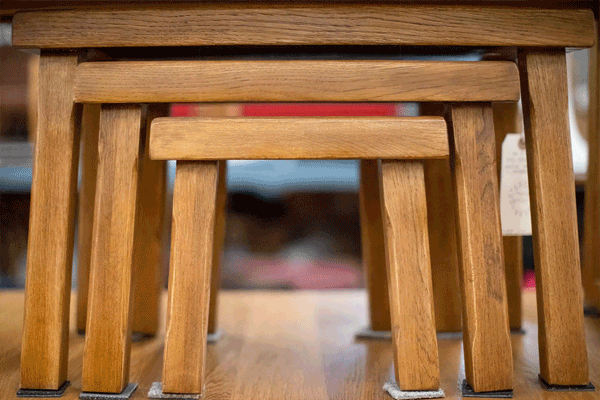Old-Fashioned Desks Roll ‘Round Again
The roll-top desk was an office favorite for decades beginning at the turn of the century. An office worker could close the desk by rolling down its top, a piece of canvas faced with strips of rounded wood.
The canvas was set into the top much like a window shade. It could be opened or closed on the wooden side tracks. The simplest form is called a C-roll.
Early roll-top desks were large and heavy and made of black walnut, cherry or mahogany. By 1900, most of them were made of oak.
It was not until the 1970s that roll-top desks became popular for home use.
*
Q: I overheard a shopkeeper talking about a lady’s spit cup. What is it?
*
A: A spit cup was part of every lady’s toilette set in the late 1800s. The woman used it after brushing her teeth. She would rinse her mouth and spit into the cup.
A spit cup has a handle, with an opening below the rim for emptying.
Some versions sell for about $150.
*
Q: I understand that three southern African countries have been given permission to begin selling ivory tusks again. Will the price of old ivory pieces go down?
*
A: The prices of antique, carved ivory pieces are not likely to be affected by the sale of nearly 60 tons of stockpiled ivory to Japan.
Experienced ivory collectors usually can tell old ivory carvings from new ones by comparing the quality of the work and the patina.
In June, the nations that are party to the Convention on International Trade in Endangered Species agreed on a plan that allows Zimbabwe, Botswana and Namibia to sell their stockpiled elephant ivory.
Collectors should learn to distinguish between elephant ivory, walrus tusks, whale teeth, boar teeth, mammal bones, celluloid and other plastics. The differences can be found in the grain, density, color and hardness of each material.
Elephant ivory is the most dense. The grain of elephant ivory has a ring-like growth pattern similar to a tree. It has wavy lines moving in a single direction.
*
Q: A doll of mine is marked “The Princess Doll.” It belonged to my grandmother. I think it is about 70 years old. Can you tell me more about it?
*
A: The American Unbreakable Doll Corp. of New York City marked its Princess line of dolls with that name. The round mark has a picture of a child and a doll and the words “The Princess Doll.” The mark was used beginning in 1923.
*
Q: My mother-in-law gave me a large, hand-painted porcelain vase that she claims is 400 years old. There’s a smudged mark on the bottom picturing a crown in the middle with “E.P. Co.” above it and something under it that ends: “Works, Stoke-on-Trent, England.” Can you help me determine who made the vase and when it was made?
*
A: Your vase was made by the Empire Porcelain Co. at Empire Works, Stoke-on-Trent, Staffordshire, England. In the mark, the word in front of “Works” is “Empire.”
The vase was made between 1912 and 1928.
*
Q: I have a Rose Leaves pattern pressed-glass goblet. It’s clear glass with a plain stem and rim and a pattern of small rose leaves around the bottom two-thirds of the goblet. What else was made in this pattern?
*
A: Your goblet, made by an unknown manufacturer, dates from about the 1880s. It is worth about $25. The Rose Leaves pattern has been seen only on goblets.
If you want other information about antiques, include a self-addressed, stamped (55 cents) envelope, and the Kovels will send you a listing of helpful books and publications. Write to the Kovels, Los Angeles Times, King Features Syndicate, 235 E. 45th St., New York, NY 10017.
(BEGIN TEXT OF INFOBOX / INFOGRAPHIC)
Current Prices
Current prices are recorded from antiques shows, flea markets, sales and auctions throughout the United States. Prices vary in different locations because of local economic conditions.
* Black Mammy syrup pitcher, Fitz & Floyd, 6 inches: $55.
* Pearlized plastic purse, amber, Bakelite, upright rigid handle, gold trim, rectangular, 1950s: $235.
* Woody Woodpecker alarm clock, Woody’s Cafe theme, Columbia Time Products, 1959: $265.
* Teco mug, raised design of cattails and leaves, matte green, gunmetal black glaze, 6 inches: $325.
* Bye-Lo Baby doll, bisque head, blue sleep glass eyes, cloth body, Grace Putnam, 1920, 13 inches: $410.
* Windsor chair, bamboo turned, bird-cage arms, circa 1810, stamped “G. Gaw”: $440.
* Superman doll, composition and wood, cloth cape, jointed, Ideal, 1930s, 13 inches: $825.
* Pepsi Cola door push, “Drink Pepsi Cola, 5 Cents, Worth Twice Its Price,” 1930s: $1,100.
* Carnival glass punch set, Peacock at the Fountain pattern, amethyst, 10 pieces: $1,330.
* Sterling-silver trivet, three sections, octagonal, four paw feet, F. Bucher & Sons., circa 1877, 13 inches: $1,750.
More to Read
Sign up for Essential California
The most important California stories and recommendations in your inbox every morning.
You may occasionally receive promotional content from the Los Angeles Times.










